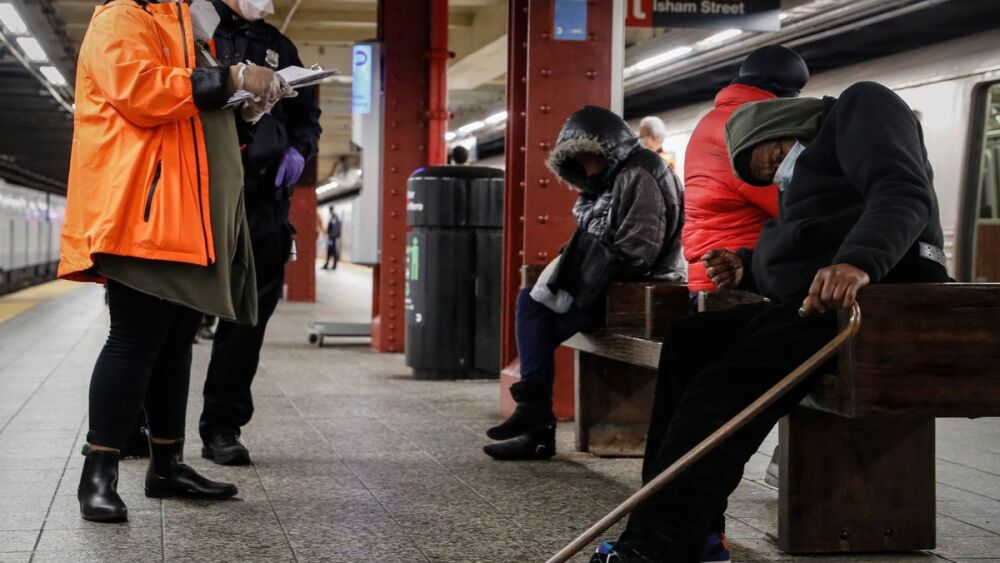By Douglas M. Wolfberg, Esq.
New York CityŌĆÖs Mayor recently announced an initiative that is, on the surface, aimed at addressing ŌĆ£the ongoing crisis of individuals experiencing severe mental illnesses.ŌĆØ Despite the cityŌĆÖs top politician packaging this as a mental health initiative, the media is widely reporting that its real objective is cleaning up the cityŌĆÖs subways. Without a doubt, the MayorŌĆÖs initiative comes on the heels of recent headline-grabbing murders, assaults and robberies purportedly perpetrated by people in the mentally ill and homeless populations ŌĆō many occurring on subways and in subway stations.
Controversial political directives aimed at EMS
What makes this initiative controversial from an EMS perspective is the fact that the MayorŌĆÖs office also issued a directive to city agencies ŌĆō including EMS ŌĆō setting forth new requirements that EMS clinicians must follow to ŌĆ£involuntarily removeŌĆØ individuals under the stateŌĆÖs mental health law. Even more controversially, city politicians are basing these new EMS mandates on an aggressive, untested interpretation of that law, which may leave EMS clinicians in an untenable spot, as IŌĆÖll explain below.
In my view, political directives purporting to require EMS clinicians to engage in certain clinical practices should raise warning signs for EMS across the country. And EMS providers are expressing serious concerns ŌĆō as well they should ŌĆō since this approach has frightening consequences for EMS clinicians, EMS systems and patients alike.
First, let there be no mistake: the scourge of mental illness, especially when coupled with the plague of homelessness in our nationŌĆÖs cities, is a crisis that requires new thinking and bold action. To the extent New YorkŌĆÖs policy is rooted in a desire to help solve this crisis, it certainly deserves recognition. But the more I read the directive, and the more I read the MayorŌĆÖs statements, the less I think this policy is actually about helping the mentally ill. To me, it seems to more clearly be an effort to clean up the cityŌĆÖs subways under the guise of caring for mentally ill and homeless populations. And the policy conflates mental illness with homelessness. Although there is often a correlation between the two, it is not always the case, and therein lies one of the real challenges for EMS.
Legal standards for involuntary intervention
Most state mental health laws permit involuntary removal, treatment or commitment of individuals under a standard of ŌĆ£likely harm to self or others.ŌĆØ That is, most state laws, including New YorkŌĆÖs, provide that certain designated practitioners can furnish treatment to an individual even without their express consent, or even over their express objections, when the individuals are conducting themselves in a manner likely to result in serious harm to the individual or to others. Under this standard, a healthcare practitioner would be obligated to conclude that imminent, serious harm is likely in order to justify involuntary treatment, removal or transport of an individual.
It is important to remember that in the United States, we begin from a baseline of individual freedom and autonomy, which includes a federal constitutional right to refuse unwanted medical care. This has been a recognized individual liberty under the for decades. The standard for any deprivation of a personŌĆÖs freedom and bodily integrity is rightfully high, and it shouldnŌĆÖt be easy for healthcare practitioners to impose their will on patients.
The gray area, of course, is ascertaining when a person no longer has the legal right to make their own decisions. When can healthcare providers lawfully treat or transport a person regardless of the personŌĆÖs own wishes? Under this novel New York interpretation, the city is significantly expanding the conditions for involuntary removal through what it calls the ŌĆ£basic needsŌĆØ standard.
The Basic Needs Standard: an untested political interpretation of the law
NYCŌĆÖs aggressive interpretation of the stateŌĆÖs mental health law would allow for involuntary intervention by qualified clinicians when a personŌĆÖs ŌĆ£mental illness prevents them from meeting their own basic needs.ŌĆØ The cityŌĆÖs invocation of this so-called ŌĆ£basic needsŌĆØ standard directs EMS practitioners to treat, remove and transport a person without their consent simply when mental illness prevents them from caring for themselves. The theory, says the Mayor, is that an inability to meet oneŌĆÖs own basic needs poses a danger sufficient to trigger the procedures of the stateŌĆÖs mental health law. An interesting fact about the MayorŌĆÖs untested interpretation is that his statement also says that his office ŌĆ£will work to have the ŌĆśbasic needsŌĆÖ standard for involuntary intervention explicitly written into state law.ŌĆØ This means the Mayor is requiring EMS clinicians to take actions that are not expressly authorized under any state law. ŌĆ£WeŌĆÖre not exactly sure itŌĆÖs legal but do it anywayŌĆØ seems like a muddled and risky directive.
Under the cityŌĆÖs ŌĆ£basic needsŌĆØ theory, the MayorŌĆÖs directive specifically states that the requisite standard for involuntary intervention is met ŌĆ£even when no recent dangerous act has been observed.ŌĆØ In other words, EMS providers are effectively being required to intervene and transport persons merely because they are homeless and apparently mentally ill. The MayorŌĆÖs directive seems to presume that the requisite ŌĆ£danger to self or othersŌĆØ is met merely by the combination of homelessness plus apparent mental illness.
Required EMS interventions
The required EMS interventions under the directive are to:
- Transport the individual to the closest hospital;
- Perform EMS assessment and treatment per protocols;
- Remain with the patient until they have been registered by the hospital as a patient; and
- Document the removal in ePCR
Perhaps most interestingly, the directive also requires a police officer to accompany the patient in the ambulance during transports of involuntarily removed persons. It remains to be seen whether police officers will accede to these requirements, or whether there will be confrontations between EMS and law enforcement if officers refuse to ride along during these transports.
Not only does this political directive interfere with independent clinical judgment and decision-making by EMS providers, but it also carries built-in risks for the providers themselves as well as untoward consequences for the EMS system.
EMS consequences
One FDNY paramedic, in a , openly declared that the MayorŌĆÖs political directive poses dangers to EMS clinicians, who will be forced into situations they are often not equipped to handle. The directive will also vastly increase the number of these encounters that EMS providers are already called to handle, and thus increase the exposure to danger. In addition, this paramedic ŌĆō also an FDNY EMS lieutenant ŌĆō noted that forcing EMS practitioners to ŌĆ£bundle people into our ambulances against their willŌĆØ will break the trust that clinicians must have from their patients. ŌĆ£Without [trust], we wouldnŌĆÖt be able to get patients to talk to us, to let us touch them or stick needles filled with medications into their arms.ŌĆØ
As listed above, another component of the MayorŌĆÖs directive requires EMS providers to ŌĆ£remain with the patient until they have been registered by the hospital as a patient.ŌĆØ Aside from the fact that this part of the directive might violate Federal law (which assigns the duty of care to the hospital upon the patientŌĆÖs arrival on hospital property), this will undoubtedly tie up ambulances for hours on end while already overburdened hospitals delay registering incoming EMS patients.
The EMS systems in many large cities are already at the breaking point in terms of capacity (including the endurance and wellness of the EMS clinicians themselves), and removing these unit hours from service in the community while facing indefinite offload times may well be a crippling blow to the system. I canŌĆÖt imagine how victims of sudden strokes, STEMIs or trauma ŌĆō or their family members - will feel when they learn that their EMS response and definitive care was substantially or even fatally delayed because the CityŌĆÖs ambulances and EMS clinicians were spending hours of unnecessary downtime inside hospital EDs.
New legal liability?
I also harbor concern for the legal liability of individual EMS clinicians when the lawsuits start. Notwithstanding the MayorŌĆÖs assertion that EMS clinicians are ŌĆ£authorizedŌĆØ to engage in these involuntary interventions, thereŌĆÖs no guarantee that the aggressive political interpretation of state law wonŌĆÖt simply be found to be wrong when courts start to examine it more closely. The MayorŌĆÖs directive specifically states, ŌĆ£case law does not provide extensive guidance regarding removals for mental health evaluations based on short interactions in the field.ŌĆØ I fear that will change in a hurry. It is quite likely that case law will begin to provide such guidance in earnest when civil rights lawsuits against EMS and other clinicians start being filed and adjudicated after this directive.
Although the MayorŌĆÖs stated reason for this new policy is to provide proper mental health care for ŌĆ£allŌĆØ New Yorkers in need, one canŌĆÖt help but notice that the MayorŌĆÖs press statement uses the word ŌĆ£subwayŌĆØ a dozen times. It is even more likely that courts will become skeptical about a policy with a stated purpose of providing mental health treatment when it really seems to be aimed at a political objective of ŌĆ£cleaning up the subways.ŌĆØ The directive itself is also rife with inconsistencies, citing conflicting standards throughout the five-page document and raising even more questions for practitioners.
Exacerbating EMS challenges
New York EMS clinicians work for the city, and therefore, the Mayor is their ultimate boss. EMS clinicians shouldnŌĆÖt be put in the impossible situation of having to choose between following their employerŌĆÖs work rules (especially when there is ample evidence that those rules are politically motivated) and the potential dangers and legal risks of involuntarily treating and removing individuals under a novel and still untested interpretation of state law.
Direct political involvement in EMS clinical care isnŌĆÖt new, and this isnŌĆÖt the first time itŌĆÖs been done (the Colorado EMS ketamine law is another recent example). But what this latest directive clearly shows is that politicians shouldnŌĆÖt be dictating EMS clinical standards or using EMS agencies to achieve their political objectives. The mental health crisis is acute and requires solutions. Using EMS as a band-aid isnŌĆÖt a good one. A policy requiring already overburdened EMS systems to carry out forced removals of people from subways and taking them to overcrowded hospitals ŌĆō when it is virtually certain they will be kicked right back out to the streets and subways ŌĆō will only create a revolving door of new problems, while exacerbating other more deeply rooted challenges already faced by our EMS systems.
EMS One-Stop With Rob Lawrence
Listen for more as Doug Wolfberg and Rob Lawrence discuss the directive.
About the author
Doug Wolfberg is an EMS attorney and founding partner of Page, Wolfberg & Wirth, LLC, the nationŌĆÖs leading EMS law and consulting firm. The opinions expressed herein are solely the authorŌĆÖs.












